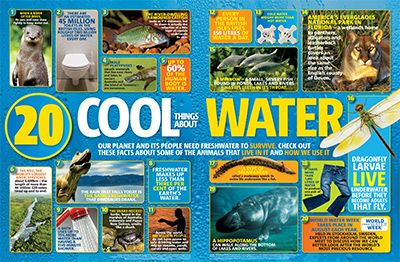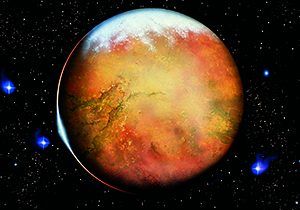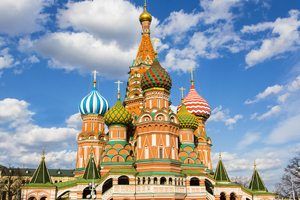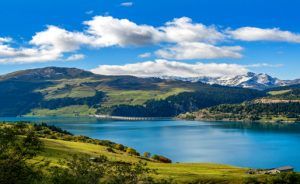
Water Facts Primary Resource
Discover fascinating facts about the world’s most precious resource…
 This science primary resource features twenty facts about freshwater, with a focus on we use water and the amazing animals that live in it. How much water do we use a day on average? How are river otters adapted to diving? How many people around the world don’t have access to safe drinking water?
This science primary resource features twenty facts about freshwater, with a focus on we use water and the amazing animals that live in it. How much water do we use a day on average? How are river otters adapted to diving? How many people around the world don’t have access to safe drinking water?
As well as learning fascinating water facts and statistics, pupils will gain an understanding of the importance of protecting this invaluable resource in our National Geographic Kids’ Science primary resource sheet.
N.B. The following information for mapping the resource documents to the school curriculum is specifically tailored to the English National Curriculum and Scottish Curriculum for Excellence. We are currently working to bring specifically tailored curriculum resource links for our other territories; including South Africa, Australia and New Zealand. If you have any queries about our upcoming curriculum resource links, please email: schools@ngkids.co.uk
This primary resource assists with teaching the following Key Stage 2 Geography objectives from the National Curriculum:
Pupils should be taught to: describe and understand key aspects of:
- physical geography, including: climate zones, biomes and vegetation belts, rivers, mountains, volcanoes and earthquakes, and the water cycle
- human geography, including: types of settlement and land use, economic activity including trade links, and the distribution of natural resources including energy, food, minerals and water
This primary resource assists with teaching the following Key Stage 1 Science (Year 1) objectives from the National Curriculum:
Pupils should be taught to:
- identify and name a variety of common animals including fish, amphibians, reptiles, birds and mammals
- describe and compare the structure of a variety of common animals (fish, amphibians, reptiles, birds and mammals, including pets)
National Curriculum Key Stage 1 Science (Year 2) objective:
Pupils should be taught to:
- identify that most living things live in habitats to which they are suited and describe how different habitats provide for the basic needs of different kinds of animals and plants, and how they depend on each other
- identify and name a variety of plants and animals in their habitats, including micro- habitats
- find out about and describe the basic needs of animals, including humans, for survival (water, food and air)
National Curriculum Key Stage 2 Science (Year 4) objective:
- recognise that environments can change and that this can sometimes pose dangers to living things.
This primary resource assists with teaching the following Social Studies Early level objective from the Scottish Curriculum for Excellence:
- I explore and appreciate the wonder of nature within different environments and have played a part in caring for the environment
Scottish Curriculum for Excellence First level Social Studies objectives:
- By exploring a natural environment different from my own, I can discover how the physical features influence the variety of living things
Scottish Curriculum for Excellence Second level Social Studies objectives:
- I can discuss the environmental impact of human activity and suggest ways in which we can live in a more environmentally- responsible way
Scottish Curriculum for Excellence Third level Social Studies objectives:
- I can identify the possible consequences of an environmental issue and make informed suggestions about ways to manage the impact
Scottish Curriculum for Excellence Fourth level Social Studies objectives:
- I can discuss the sustainability of key natural resources and analyse the possible implications for human activity
- I can develop my understanding of the interaction between humans and the environment by describing and assessing the impact of human activity on an area
This Science primary resource assists with teaching the following Sciences Early level objectives from the Scottish Curriculum for Excellence:
- I have observed living things in the environment over time and am becoming aware of how they depend on each other
Scottish Curriculum for Excellence Second level Science Studies objective
- I have investigated different water samples from the environment and explored methods that can be used to clean and conserve water and I am aware of the properties and uses of water
- I can identify and classify examples of living things, past and present, to help me appreciate their diversity. I can relate physical and behavioural characteristics to their survival or extinction.
Scottish Curriculum for Excellence Sciences Third level objectives:
- I can sample and identify living things from different habitats to compare their biodiversity and can suggest reasons for their distribution.
Download primary resource
More Like

Facts about Mars

Russia facts

Earth Day!









LEAVE A COMMENT
THANK YOU
Your comment will be checked and approved shortly.
WELL DONE,
YOUR COMMENT
HAS BEEN ADDED!
COMMENTS
CUSTOMIZE YOUR AVATAR